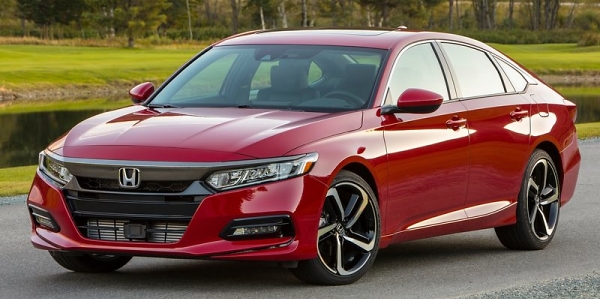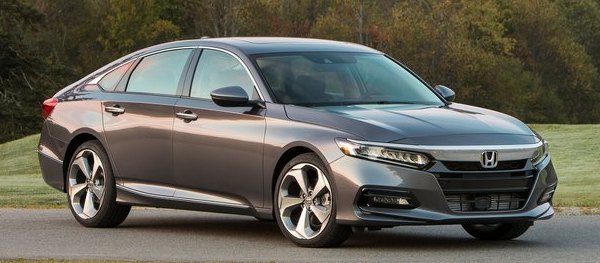Published
on 27
Oct 2017
|
All rights reserved.
|
|

|
|
Questionable
styling aside, the new Accord is a great family sedan in all aspects.
|
|
The outgoing Honda Accord
was not exactly a good-looking car. Comparatively, the new, 10th
generation Accord has a much sleeker shape. Viewing from the back, it
is even quite stylish. However, turning to the front will find Honda’s
styling department still suffers from a questionable taste. Its fascia
looks
messy and its headlights are oddly toppled by the extensions of the
chrome grille. There are too many crease lines on its clamshell bonnet
and too many busy details on the front bumper. Car design doesn’t need
to be too complicated. Keep it simple like Volvo may appeal to wider
audiences rather than only those with acquired taste.
Its proportion isn't perfect either. There are sedans and fastbacks in
the mid-size family car segment, but the new Accord seems undecided on
which way to go. The result is a fastback followed by a small boot,
which is neither elegant nor beneficial to luggage access.
The side profile is similarly flawed. It adopts a banana-shape side
profile that so far only Mercedes-Benz succeeded.
Since Honda is no Mercedes, the Accord looks a little fat in the
middle, just like an average American
man in his 40s. Yes, the Accord is 41 years old now.
Anyway, its proportion is unquestionably sportier than that of its
predecessor. Honda managed to cut 10mm from its length but inserted
55mm to
its wheelbase, extending the latter to a competitive 2830mm. Meanwhile,
the car gets 10mm wider and 15mm lower. Its center of gravity is
lowered by 10mm as well.

|
|
Sleek
interior design is matched with near-VW level of quality.
|
|
Inside, the extended wheelbase liberates a massive 50mm for rear
legroom, making it not only the roomiest in the class but also far
ahead of its key rivals Toyota Camry and Ford Fusion. By putting the
front seats
closer to the center line, hip and shoulder room are improved as well.
Rear headroom suffers a 5mm drop due to the lower roof line, but it is
still more than Camry. The only minor drawback is that the sloping roof
rails make taller passengers more difficult to get into the rear seat.
Overall, its cabin space tops the class and approaches the level of
E-segment.
Despite the small aperture, the luggage compartment is one of the
largest in the class. Brilliantly, the Hybrid model offers the same
cargo space and
split-folding rear seats as the battery gets smaller and fits entirely
under the rear seat.
Up front, the driving position is perfect, outward visibility is helped
by slim A-pillars if not the fast-angle rear window. The front seats
are comfortable yet offer good lateral support, which is crucial to a
car traditionally emphasizing driver appeal. The overhauled dashboard
gets simpler, sleeker and more functional. Free-standing 8-inch
touchscreen is clear and easy to use. Another high-resolution TFT
screen occupies 2/3 of the instrument pod to display either a rev
counter or sat nav map etc. (The speedometer on the other side is real)
It feels suitably classy and high-tech. Honda leaves hardware dials for
climate control, and their precision and feel matches Volkswagen’s.
Speaking of quality, the dashboard is made of soft-touch plastics,
trimmed with soft leather and pretty decent faux wood inserts. It is a
vast improvement from the old car, and it beats Camry convincingly.
While Volkswagen remains the benchmark of the class, the Accord is very
close in quality perception, and it feels warmer and more inviting.

|
|
2.0T
engine is strong and willing, mates perfectly with the new 10-speed
automatic.
|
|
The chassis is also a sizeable improvement from the old car. 54 percent
of the monocoque chassis is made of high-strength steel, in which 29
percent is ultra-high-strength steel. As a result, torsional
rigidity is lifted by 32 percent, while kerb weight is reduced by 50-80
kg depending on models. The suspension continues to be MacPherson
struts up front and multi-link at the rear, but there are plenty of
improvement. The front suspension replaces steel lower wishbones with
L-shape aluminum control arms, which are not only lighter but better
isolated from lateral forces. The front subframe is also made of
aluminum to save weight. Rear subframe remains steel but are made
stronger. All four suspensions are mounted through hydraulic bump stops
for better NVH suppression. Moreover, electronic adaptive dampers are
finally available, although on the top Touring model only.
The case of 80kg weight saving must be the range topper, because it
follows the segment trend to abandon V6 for a 2-liter direct-injection
turbo. This one is detuned from the Civic Type R's, sharing many
goodies such as dual-variable cam phasing and exhaust variable valve
lift – the latter facilitates scavenging effect to help spooling up the
turbo more quickly. It produces 252hp and 273lbft, more than the
counterparts on Ford Fusion, Chevrolet Malibu, Hyundai Sonata and even
BMW 330i. Compared with the old 3.5 V6 though, it loses 26 ponies, but
it strikes back with more torque, and way more at lower rpms. In the
real world, this engine feels even more energetic than the figures
suggested. It helps the large Accord to do 0-60 sprint under 6 seconds.
Power delivery is smooth, flexible and almost free of turbo lag. It
pulls
happily from 1500 rpm and spins eagerly towards the 6800 rpm redline.
Such a sweet manner is outstanding for a turbocharged four.
The 2.0T engine normally mates with a new 10-speed automatic – yes, 10
speeds! – whose ratio spread is a massive 68 percent wider than the old
6-speeder yet weighs 10 kg less. It shifts smoothly and quickly. The
optional 6-speed manual is less impressive. Honda is still the only
major Japanese car maker retaining manual gearbox option for American
customers, but few people actually choose it, thus the Accord has to
settle with a manual box carried over from the old car. The gearstick
is quite a joy to row, but the clutch travel is too long and non-linear
for fast changes. Moreover, road tests found the manual gearbox adds
half a second to 60 mph, a price too much to
pay!

|
|
You
think the new Camry might give Honda some troubles? Not at all, Accord
remains clearly superior in chassis dynamics...
|
|
However, only 20 percent buyers are expected to take the 2.0 Turbo. The
majority will choose the more affordable 1.5-liter direct-injection
turbo which comes from Civic. It produces 192hp and 192 lbft, not only
signiciantly more powerful than the 1.5-liter turbos of Volkswagen and
Ford, but also eclipses the old 2.4 VTEC. Inevitably, the smaller motor
needs to work harder than the 2.0T. It shows a bit more turbo lag low
down and needs to rev beyond 2000 rpm to deliver real shove. At the
upper end it sounds coarser, which is made even more obvious if mated
to the CVT. Some said Honda builds the most matured CVT on the market,
but even so it still fails to completely rectify the noisy drone under
hard acceleration. Take the 6-speed manual instead and it feels
sweeter, but tell me how many family buyers in the USA will choose this
combo? If the driver cares more about driving excitement than
day-to-day convenience, he might have already chosen the 2.0T manual.
That said, drive the Accord normally and the CVT will perform smoothly
without spoiling the pleasure.
What about Accord Hybrid? It is the least appealing of the trio because
the powertrain combo of Atkinson-cycle 2-liter and 2 electric motors
are largely carried over. It might make a bit more horsepower, drink a
bit less fuel and no longer eat into cargo space, but the progress is
not as remarkable as the turbos. Traditionally, Accord Hybrid is a
commercial failure. Good luck this time.
Back to the regular Accords, apart from remarkable engine and
performance, they also display remarkable ride and handling for a large
family car. You think the new, sportier Camry might give Honda some
troubles? Not at all, Accord remains clearly superior in chassis
dynamics. Even without the help of adaptive dampers, it combines a
fluid ride with taut body control. Its dual-pinion electric power
steering is still a bit too light and short of feel, but it is accurate
and loads up naturally in corners. Compared with the old V6, the new
2.0T feels lighter on its feet. The nose is willing to turn-in, then
the body resists roll strongly in corner and it behaves predictably at
the limit. The brakes have real bite. As for refinement, the ride is
supple. Mid-corner bumps don’t hurt its composure much. Engine and wind
noise are well insulated from the cabin, but road and tire noise
remains evident, which is probably the biggest disappointment of the
car.
The new Accord has a lot to like, from engine, chassis, space, quality,
ease of use to value for money. Such qualities rarely happen
simultaneously on a mainstream brand family car. Its only weaknesses
are the slightly odd looks and excessive road noise, but those are not
difficult to swallow. Honda finally makes a class winner again.
|
Verdict:     |
|